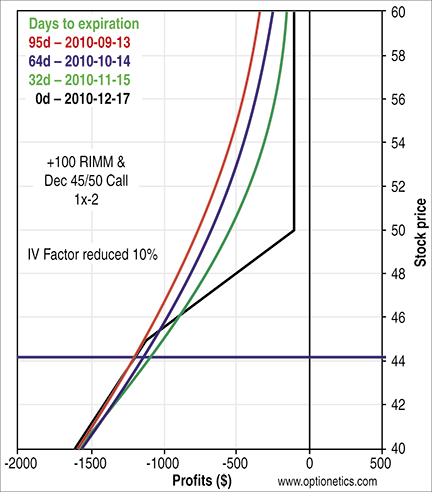Q&A

Explore Your Options
Got a question about options? Tom Gentile is the chief options strategist at Optionetics (www.optionetics.com), an education and publishing firm dedicated to teaching investors how to minimize their risk while maximizing profits using options. To submit a question, post it on the Stocks & Commodities website Message-Boards. Answers will be posted there, and selected questions will appear in future issues of S&C.
GETTING EVEN FOR FREE?
Can any option strategies help with an unrealized loss on a stock position without putting additional capital at risk?
Yes, there is. In this type of situation, a trader can apply a buy-write strategy where a call is sold one-for-one against the existing shares held. An offshoot of this strategy and perhaps a bit more clever is to execute a ratio front-spread in order to ratchet down the breakeven even further.
The combined position, which consists of +1 call x -2 higher strike calls against an existing position of +100 shares, works like owning two buy-writes at the sold strike if shares reverse course and rally higher. But if the stock continues to move lower, the trader maintains the risk associated with the originally held long stock as the spread will go out worthless at expiration.
Remember, due to the construction of our combined position, the trader owns one buy-write and one limited risk bull vertical spread. When the front-spread is executed for even money or a credit, the trader avoids the cost associated with averaging down with either stock or a long call.
Shown in Figure 1 to illustrate the front-spread in conjunction with previously acquired long stock is Research In Motion (Rimm). Let’s say a trader bought 100 shares of Rimm back in late July at $56.50 when it appeared the stock was staging a low-level breakout.

figure1: RIM (RIMM) REPAIR STRATEGY
By mid-September a couple days ahead of Rimm’s earnings report, the stock was trading near $44.25. Ever hopeful, the trader wished to stay the course to breakeven, but also realized a revisit to $56.50 wasn’t likely anytime soon. One front-spread available and worth considering was the December 45/50 call 1 x -2.
Due to a rather tough loss in excess of 25% already, using the front-spread and breaking even is more than difficult to do without going too far out. In fact, our illustration only manages to show a best-case scenario of losing -$100. However, as the risk graph depicts, that small loss is possible at expiration at $50 a share rather than breaking even up at $56.50. There is the possibility the trader may also be able to roll and further reduce his or her breakeven or adjust into another strategy at a more advantageous starting point than would otherwise be the case.
Now it’s time for the disclaimer and something that needs to be addressed by the individual trader. First, there is the downside risk associated with long stock that remains unprotected from further losses should shares continue to fall. Second, this type of position does cap the upside potential by selling the calls. If a strong-enough stock move were to occur in the intended direction but one that the trader wasn’t able to adjust for, they’d need to be content with what they accomplished in executing the front-spread.
Worse yet, prior to expiration the front-spread could impede progress toward breakeven as the two contracts sold could expand in relation to the purchased contract. That type of result is shown with the pre-expiration risk lines, despite a conservative 10% reduction to implied volatility.
Finally, there is both the emotional and financial toll, which might be further increased if a trader relies too heavily and/or too often with this strategy. In the end, this type of adjustment falls into the category of “getting even.” Most would agree the better course of action is typically to minimize losses in a timely manner and put one’s resources into stronger situations currently available that might otherwise be missed.
SCALPING GAMMA? REALLY?
I’ve heard one strategy option that pros employ is “scalping gamma.” I’m just learning about the greeks associated with option trading and am having difficulty grasping what this means. Can traders actually buy and sell gamma?
The expression generally refers to traders scalping stock (typically) against an option position that maintains long gamma or long curvature. Gamma, as you’re learning, is the greek factor responsible for shifting a call’s or put’s delta over the course of a one-point move in the underlying stock.
As the stock rallies or declines and builds up a position’s positive or negative delta count (respectively), traders will look to reduce the increased directional risk by selling shares on a swing higher or buying stock as it moves lower in order to flatten out the delta risk back toward zero. The more scalps of selling high and buying lower a trader is able to execute over the life of a long gamma position, the closer to profitability they will get.
Before profitability can be realized, decay or theta must be overcome. Volatility or vega risk could also act as a hazard to the position. Such would be the case if a trader held a long straddle and strangle, which also happen to be the simplest types of long gamma positions.
As theta risk can be calculated daily, many “long curve” traders will assess how a position is playing out by determining whether they’re being compensated to scalp gamma by making a consistent profit above and beyond their daily decay risk. If they’re applying their stock scalps in such a way that paper profits are being built and the trader isn’t concerned with their vega risk, scalping gamma and those attached deltas can be another way to successfully explore your options.
Contributing analysis by senior Optionetics strategist Chris Tyler.